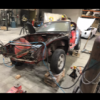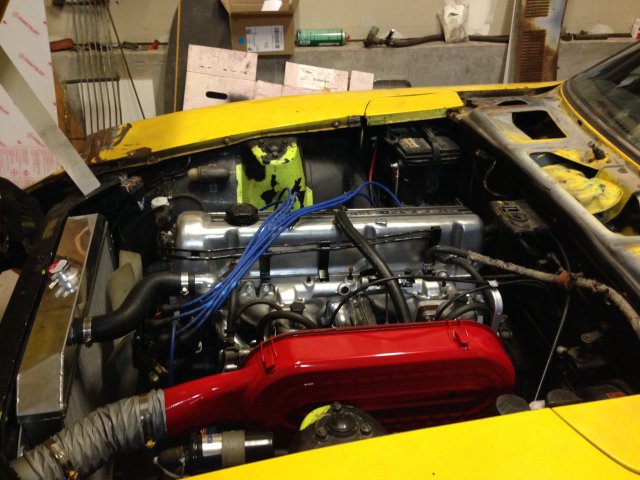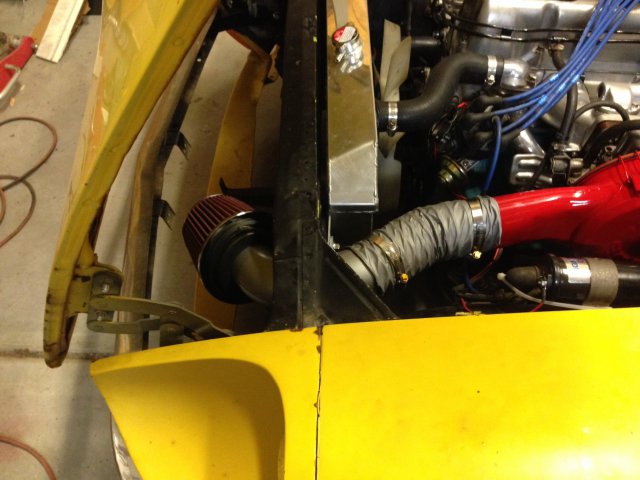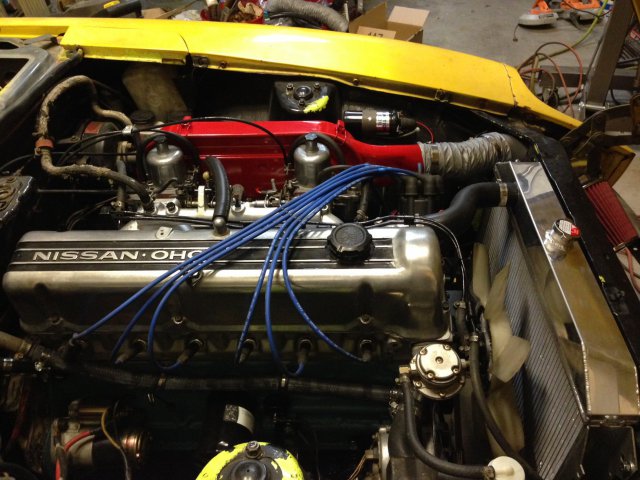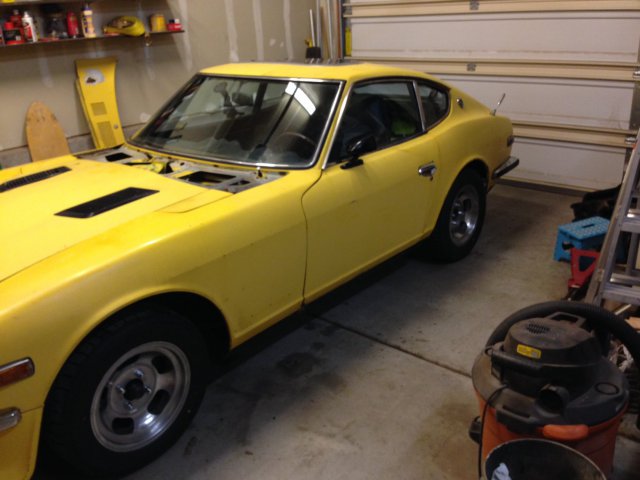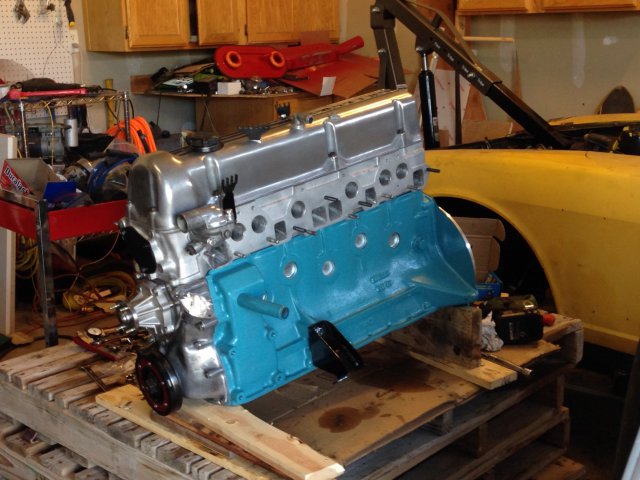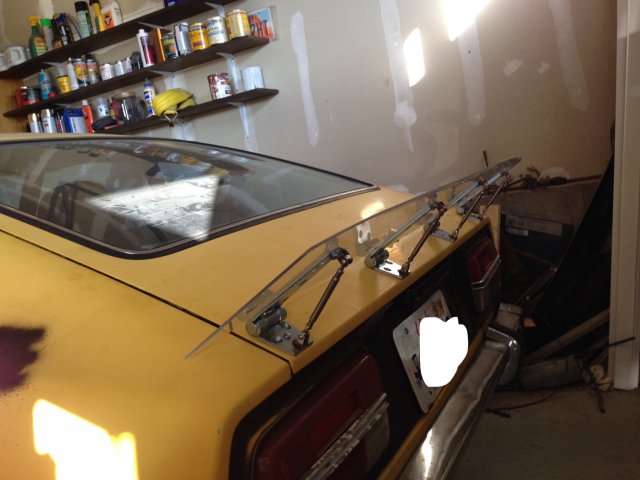
Bruggles
Members-
Posts
18 -
Joined
-
Last visited
Contact Methods
-
Website URL
www.leantempo.com
Profile Information
-
Location
Utah
Recent Profile Visitors
1445 profile views
Bruggles's Achievements
Newbie (1/14)
0
Reputation
-
1972 240z Build Thread - Budget Racer
Bruggles replied to Bruggles's topic in S30 Series - 240z, 260z, 280z
As far as intended use I would like to autocross, drive the car on road courses, and drive around town occasionally. My closes course is Utah Motorsports campus and I try to do events 1x per month. I haven't decided how much I can spend on wheels/tires yet and am just starting to look so I can set a realistic budget. For the wheel setup pic there is a pic in this thread a few posts ago that has a side shot where you can see the wheels. -
Well, it looks like there is a bad bearing or 2. The oil looked clean from the pan, but this is what came from the filter so I will be pulling the engine to investigate and fix the problem. I will also be adding an oil scraper, an oil cooler (this will be cheap insurance to prevent this in the future) and looking to see if I can retard timing and keep performance to possibly have it run a little cooler in the future. I tried to get a scraper from Ishihara-Johnson scrapers to no avail (I talked to Kevin a few months ago to place the order and it still hasn't shipped) so I will measure it all and get them cut - would anybody else like one for a 280z crank?
-
Thanks for the response, I am out of town, but will check more thoroughly for exhaust leaks when I get back and digging around more with a stethoscope. The noise is certainly not normal, my daughter who was in the car with me was like "whoa what is that sound" about 15 seconds after I noticed it. Although I don't like the higher temps, they certainly seem reasonable and under any normal driving the temp stays around the middle of the gauge, when driving with sustained higher rpms in 90-100 degree temps it does get up to 3/4 but drops back down quickly if I shift to drop the rpm range. I am not a huge fan seeing the oil pressure gauge go below 1/4, but even more than that sound that the was recently developed worries me. Maybe I should be more concerned about the coolant temp, and maybe it is the cause of all of this. Does anybody that races keep their temp at the same level as normal driving? This is the only car I have ever taken to the track, so I don't have anything to compare it to.
-
Okay, I have searched and tested and am not quite sure what is going on. The engine has a few thousand miles on it and has been running great. I was testing AFRs in it at different constant RPMs in 2nd gear and noticed that the temp started rising (3/4) and the oil pressure was pretty low (less than1/4) so I drove faster at a lower rpm to get the temps down. As the temp normalized and oil pressure started rising a clicking sound started. I was a couple of miles from home so drove back home to do a little diagnosis. When I got back let it run with the hood open to see if I could find the issue, it sounded like it was coming from the middle to rear of the engine from the top end and was louder on the exhaust side. I also noticed oil leaking from the head gasket - The head gasket is a felpro which have had oil leak problems with the rubber ring instead of the copper ring - so I am not sure that the oil leaking is indicative of a blown head gasket, but I am getting tempted to remove the head and check for issues. I let it cool down and started it again - The clicking sound was now intermittent, it would click maybe 3 times then not click for 6, then click... once warmed up the click is constant. I adjusted the valve clearances - none were more than .002" off, re-torqued the head, re-torqued the header and intake and restarted but the sound came back just like before. With the oil issues I was worried that it might be a rod bearing that slipped but I can't find any evidence of that - pulled the dipstick and listened with a hose and no clicking coming from down there, also pulled all plugs one at a time and it didn't change the clicking sound. I also pulled two at a time (always next to each other so 6&5 then 5&4 and so on) with no change in clicking. When I put a long extension to various parts of the motor, none are that loud - the loudest spots are the intake manifold on cylinders 3 and 4. I pulled the spark plugs and all looked normal, I also looked in the spark plug holes with a boroscope and couldn't see anything out of the ordinary - I didn't rotate the engine and look extensively but no obvious damage. Also when visually inspecting and wiggling the rockers nothing seemed out of the ordinary. I put a hose around the exhaust to see if I could hear anything and I couldn't hear anything obvious. I also checked my carb throttle plates to see if the screws were still in there and they were. Any thoughts on what I should check next? Anything that I could check without major diss-assembly? I am thinking of removing the head to check valve condition, replace the head gasket with a non-felpro gasket and replace the intake/exhaust gasket. If nothing looks obviously wrong I could drop the oil pan and look there or just drain the oil and put a boroscope in the hole while rotating the engine with the starter.
-
1972 240z Build Thread - Budget Racer
Bruggles replied to Bruggles's topic in S30 Series - 240z, 260z, 280z
Questions: - Camber vs Caster - How do you know whether you need more caster or camber in the front. I will start with the recommended settings that are found elsewhere in the forum, but anywhere I have searched all I can find is the info on how to use tire temps to adjust camber. The two are related, so any thoughts on how to know when to adjust which? - Tire size - I would like to get wider tires when these ones wear out and to do that while keeping sticky non-slick tires I will need bigger rims. Everywhere I look it says that bigger rims will slow acceleration and reduce the nimble feeling of small rims... Is it worth it to have the additional traction of wider tires? Is this really noticeable or is this just internet engineering? I am thinking of going from 195 to 245-255 wide tires so the tire in contact with the road will be much wider. The number of tires available in those widths goes up as the rim size increases, in 15" rim there is like 1 tire that wide, in 16" rim there are 5 or so and in 17" rim there are a bunch. What rim size would be ideal for all around performance (acceleration, deceleration, cornering g's, etc)? -
1972 240z Build Thread - Budget Racer
Bruggles replied to Bruggles's topic in S30 Series - 240z, 260z, 280z
The tires are wearing on the outside edges more than in the middle, and the car doesn't grip around the corners as well as I would like so the car clearly needs more camber and likely caster. I did slot the shock towers but that only gave me maybe 1/2 degree of adjustment before the spring isolator hits the towers. The plan: - Get adjustable lower control arms front and rear. I thought about building these, but when I add up the part cost, the time, and the risk it just seemed like a better idea to buy the arms. I ordered them from Apex engineered and they should be here next week. I am guessing that these still won't give me the camber that I want but should get me much closer, and I ordered a pyrometer to be able to read the tire temps and get the car much more dialed in. - In the winter I will install coil overs with camber plates. Looking at TTT weld on with TTT weld on camber plates. Not sure what spring rates - part of the reason for doing this "backwards" is that I wanted to understand the difference that proper race alignment adds without changing anything else. It is vaguely possible that I will keep my current springs... for a softer ride when not racing assuming that I don't need coilovers to clear wider tires in the future. My hope is to learn as much as I can along the way and try to disentangle the benefits of different pieces. It seems like so many people get the correct geometry by doing coilovers so it is hard to say where most of the benefit comes from and since I was planning on doing both anyways I figured this could get me part of the benefit during the race season and the part that takes the longest can be done over the winter when I don't drive the car. -
1972 240z Build Thread - Budget Racer
Bruggles replied to Bruggles's topic in S30 Series - 240z, 260z, 280z
With the "new" engine in place and running there have been a few other issues that needed sorting out. On my first track day the fuel started boiling in the float bowls while running so it was time for a better heat shield between the headers and the carbs - yes these are ceramic coated headers and a better heat shield is still needed(not just a nice to have especially for track days). I built a new heat shield from scratch, it is hard to see in the pic but basically it looks like a park bench from the side without legs and covers the whole length but largely follows the style of the original with the addition of the flat bottom part. The place that is normally cut out is a bump in this version instead and the whole thing was covered with adhesive heat reflective/insulating sheet. This now keeps the carbs much cooler, so during driving there are zero issues. With this solved, I thought I was good to go but when driving on a hot day and letting the car sit for a while it starts perfectly but then it will die or become extremely sluggish. It died on the freeway which was a pretty scary experience. After looking around it looked like vapor lock so I searched around and found that insulating the fuel rail was a good way to fix this so I insulated and isolated the fuel rail. I first slit rubber fuel lines and put them over the original steel lines. I then drilled all of the mounting holes to .420 so I could put o-rings around the studs/bolts to prevent it from touching any metal. I then wrapped it with header wrap 2x. In retrospect the adhesive stuff that I used for the heat shield might have been better to not have exposed fiberglass around the lines, but either way after testing yesterday it looks like this problem is solved. It was attached with nylon washers on both sides so it is isolated from metal all around. Here it is completed and installed. After sitting for a while it is now a little harder to start, but once it starts it runs/idles great and doesn't die 1 mile down the road. I think what was happening is that the fuel would evaporate from the bowls first and then the fuel line would heat up and it would push fuel back to the bowls but leave the lines empty. So I am going to try isolating the fuel bowls from the heat even better, maybe add another layer to the heat shield or wrap the bowls. Either way it shouldn't leave me stranded in the middle of a freeway until it cools enough to drive. Yes I am still using the mechanical fuel pump and belt driven fan. -
1972 240z Build Thread - Budget Racer
Bruggles replied to Bruggles's topic in S30 Series - 240z, 260z, 280z
pic of the car After reading some aero stuff I covered some of the radiator opening with cardboard and made a plexiglass rear spoiler. This stuff actually helped hold me down on the track a little better with the side benefit of less exhaust smell. Since the cardboard worked it has since been replaced by a plastic piece that does the same thing but adds some stiffness to the air dam and doesn't look like a piece of cardboard. With the new suspension the car felt much closer to what I was looking for, but the engine wasn't quite up to par so I took the head off to see if there were issues with the engine. It looked a little worn, and had the dished pistons which means low compression ratio so it was time for a rebuild. Some details and conversation on the build are here The basics are: - N42 Block bored out 1mm - Flat top ITM pistons with balanced rods and ARP rod bolts - Casting imperfections smoothed - Turbo oil pump - Stock 280z valve sizes with SI valves and bronze seats - Late E88 head - L490 regrind - Aluminum sprayer bar - Light port and polish on the head and matched the header and intake to the head - ARP head studs - Fidanza flywheel and new clutch - MSA ceramic coated header - New seals all around - New harmonic balancer - New aluminum radiator, water pump, hoses, etc. - Cold air intake from stock air box with Norm's child toy modification (you can see it in the background of the engine block pic) - All new hardware mix of SS and higher strength steel bolts depending on location Including all machine work and parts the rebuild came out to around $3500 The engine runs great now, quick response and great acceleration. -
Alright, first a bit of introduction. I bought my z around 4 years ago, it was in okay shape but hadn't been run for 16 years. It is the late 72 model, so some of it is early 240z and some is starting to get to 260z stuff depending on the part. When I got the car it had a "rebuilt" engine with a 280z (n42 block) and an E88 head. Not a great combo in their stock forms - anything above like 5000 RPM just didn't happen. The floors were rusted out along with some other random parts of the car. I replaced the floor pans, cleaned up the dirt, mouse poop, etc. I replaced the rubber brake lines with stainless lines and any of the steel ones that were rusted along with the calipers, rear cylinders, master cylinder, etc. I put in poly bushings all around with ST swaybars and Vogtland springs with stagg shocks. I put on some Azenis RT615K+ (195/60 R14) tires, got it running and started autocrossing it. At this point I was into the whole thing around $3500 including the purchase price of the car - not bad.
-
I am not 100% sure what the power band is for the cam, but I have more power now than I did before anywhere along the entire rpm range. It is hard to say since so many things were done at the same time, the e88 head with stock valves and stock cam limited power above like 5500 rpm. I can easily rev to 7000 now and, I never had to watch my revs before but now I really do when accelerating so I don't over rev it. it is still a timing gear run distributor and cast pistons so I don't want to take it over 7000. I think with compression around 10:1 this is great cam. Even at 2000 rpm it has great torque and response and doesn't have issues idling.
-
cam specs http://iskycams.com/cart/index.php?main_page=product_info&cPath=12_14&products_id=960 thanks for the oil starvation link, I will go read that now.
-
Yeah, I watched that same engine masters episode. My concern would be that in the corners there would be no oil left. Has anybody played with oil levels on the track to see what the impact is on oil pressure?
-
I just got ITM valves with bronze guides, so far so good. I have autocrossed them and tracked them and have like 500 street miles on them.
-
1. Currently vacuum advance is disconnected. Yes 35 + 15 seems like a lot but that is what was done on stock, so that is what I used as a baseline and bumped max vac advance down to 10 and it is too much so I disconnected. Not sure if it is worth fiddling with for a little MPG when I drive it on the street, but if someone has it working with a similar setup I would like to know how. 2. Isky stage 3. No piston to valve issues, I don't remember the clay measurements exactly, but it seems like it was in the .200 range. For valves I got SI stainless valves, springs are Schnieder cams springs, lash pads are MSA .205 ground down to center the lash. In retrospect, I am not sure that visual centering is the best method (i did measure the centering, but with calipers on the wipe mark - so visually), it seems like using a dial indicator for max valve extension would be a better way of "centering", but this was my first engine build so I didn't even think of such things. It would have been just as easy, but with a more consistent result. Next time I have the valve cover off I might take a few measurements just for curiosity's sake. The rocker arms were reground by my local machine shop since they had divots. 3.I guess I should have been more clear when mentioning the track. With autocross or just street driving I have zero issues with overheating carbs, or low oil pressure, it is on the race track that I had both of those issues. I am not on slicks, but on 200 treadwear falken azenis (they have been a pretty good sticky tire, but not as sticky as slicks). I wonder if the issue isn't the turns as much as the sustained high rpm (I didn't notice a drop in the turns, just after a few minutes on the track it was consistently measuring lower than normal) so the oil gets frothy and there is a windage cloud hanging out around the crank. I might try a little more oil, but if I could get ahold of a scraper (I might just make one) I would like to test that as a longer term engine oiling insurance policy so to speak. Out of curiosity on the track what does your oil pressure measure? on the street? Are you using a stock pressure gauge or aftermarket?
-
Well, I ended up building this motor, the cost was closer to $3500 than $2000 , but I ended up putting in ARP head and rod bolts and getting an aluminum cam oiler... I learned a ton through the process of building the engine and did all the little stuff like grinding the castings smoother and balancing the rods, and am pretty satisfied with the results. I ended up going with and Isky stage 3 and I don't know why you wouldn't go with a cam that big, no idle problems, works great with SU's etc. I sent mine in for a regrind - a great deal and got an aluminum billet oiling bar to keep it oiled. I kept my e88 head and did some light porting and moved to SS valves in the 280z sizes, I should be right around 10:1 compression. The car is pretty zippy and fun to drive. It does have some pinging only when letting off the gas completely, if I disconnect my vacuum advance this goes away. Under normal acceleration there is no pinging. Does anybody have a similar setup and if so how many degrees of vacuum advance do you run? Mine is set to 10 when plugged in and that is too much. I am also wondering if anybody has used a vacuum delay valve similar to https://www.oreillyauto.com/detail/b/bwd-3123/fuel---emissions-16775/emission-smog-parts-16465/vacuum-delay-valve-12054/0397dae098c9/bwd-2-port-egr-vacuum-delay-valve/ec314/2598329 (from the wikipedia article orange is a 2 second delay and white is forward direction - whatever that means) with the light flywheel it decelerates pretty quick and I think it just increases the vacuum almost instantly while the engine is spinning too quick. The benefit of the vacuum advance seems like it is mostly for cruising which shouldn't be impacted too much with a delayed advance. With the ceramic coated headers it still over heated the carbs with the stock heat shield on the track, so I built a new heat shield to protect the carbs from some heat and plan to drill some holes behind the battery and behind the windshield fluid reservoir to let some engine compartment air exit easier. The engine temps were fine, but it would be nice to cool the compartment a little more anyways, if for nothing else than to get rid of some of the header heat. I would also like to do an oil scraper, but am having a heck of a time getting one. I ordered one from https://www.crank-scrapers.com/Datsun-Nissan_L_SERIES.html about 3 months ago, and still don't have it and it is almost impossible to get a hold of them, my oil pressure is lower than I would like to see on the track. Any ideas where else I could get one?
